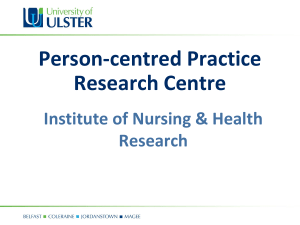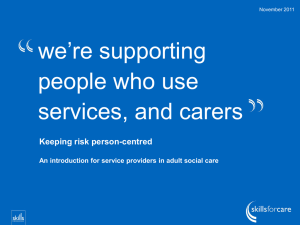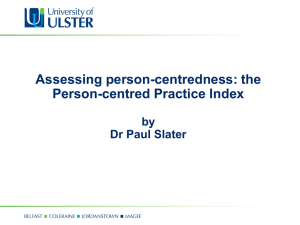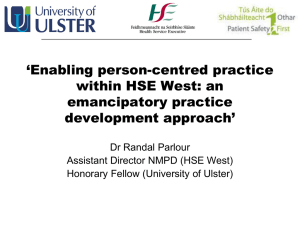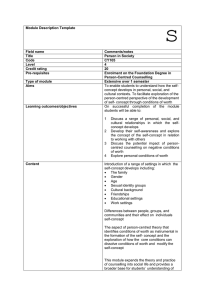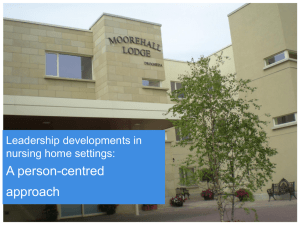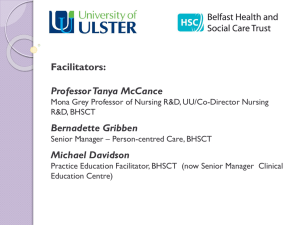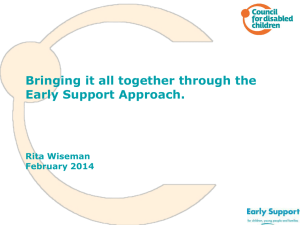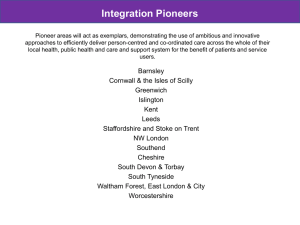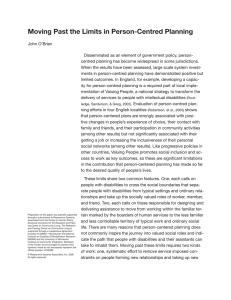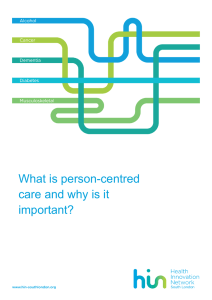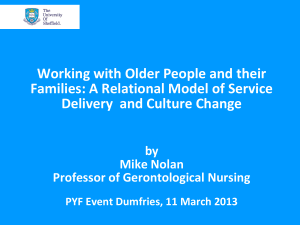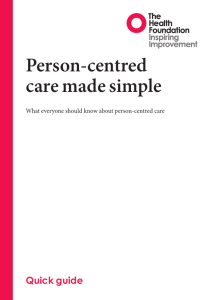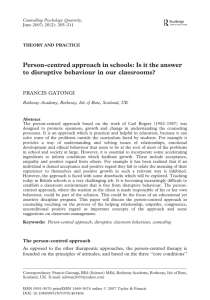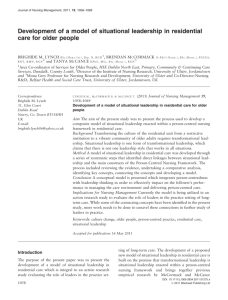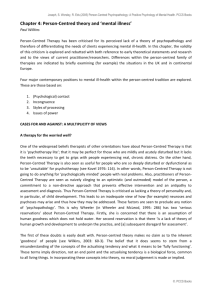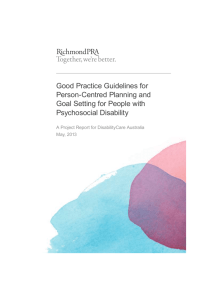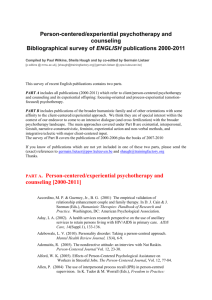Power Point Presentation - Health Service Executive
advertisement
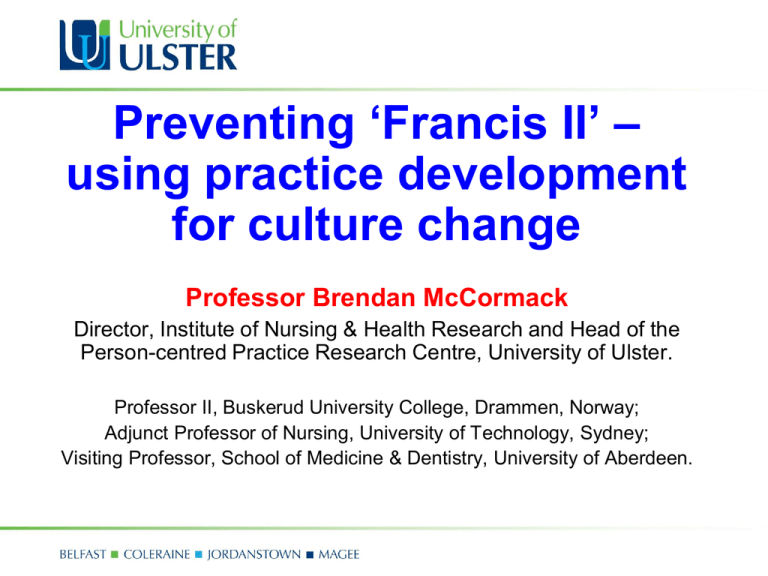
Preventing ‘Francis II’ – using practice development for culture change Professor Brendan McCormack Director, Institute of Nursing & Health Research and Head of the Person-centred Practice Research Centre, University of Ulster. Professor II, Buskerud University College, Drammen, Norway; Adjunct Professor of Nursing, University of Technology, Sydney; Visiting Professor, School of Medicine & Dentistry, University of Aberdeen. The ‘Big Agendas’ • Safety • Quality – of the patient/family experience • Staff competence and wellbeing • Person-centred outcomes Lack of a systems-wide commitment to personcentredness “… I don't think the <service name> nurses I encountered were uncaring. They were ill prepared for the tasks they faced, sometimes insensitive, unsupported by the structures and ethos of the service and very overwhelmed, but I wouldn't say they didn't care or that they didn't, for the most part, work hard. They reminded me of the adage 'the road to hell is paved with good intentions' and even if they had known more … or at least have been aware of what they didn't know, they still couldn't have functioned adequately within the structures and systems” [‘Prof Faith Gibson, 16th October 2011]. What went Wrong in MidStaffs Lack of basic care across a number of wards and departments at the Trust Culture at the Trust was not conducive to providing good care for patients or providing a supportive working environment for staff An atmosphere of fear of adverse repercussions High priority was placed on the achievement of targets Medical staff dissociated themselves from management Low morale amongst staff Lack of openness and an acceptance of poor standards; Thinking dominated by financial pressures and achieving FT status, to the detriment of quality of care Management failure to remedy the deficiencies in staff and governance that had existed for a long time Lack of urgency in the Board’s approach to some problems, such as those in governance; Stats and reports were preferred to patient experience data, with a focus on systems, not outcomes Lack of internal and external transparency regarding the problems that existed at the Trust. Warning Signs Loss of star rating – In 2004 Poor peer reviews Health Care Commission review of children’s services Audit reports – poor risk management Surveys – staff and patients Whistleblowing Professional body reports Trust’s financial recovery plan Application for Foundation Trust status – focus on targets and finance only The Trust’s Culture “The Trust’s culture was one of self promotion rather than critical analysis and openness. This can be seen from the way the Trust approached its FT application, its approach to high Hospital Standardised Mortality Ratios (HSMRs) and its inaccurate self declaration of its own performance. It took false assurance from good news, and yet tolerated or sought to explain away bad news”. Key Characteristics of the Trust’s Negative Culture lack of openness to criticism; lack of consideration for patients; defensiveness looking inwards not outwards; secrecy; misplaced assumptions about the judgements and actions of others; acceptance of poor standards; A failure to put the patient first in everything that is done. “It cannot be suggested that all these characteristics are present everywhere in the system all of the time, far from it, but their existence anywhere means that there is an insufficiently shared positive culture”. “To change that, there needs to be a relentless focus on the patient’s interests and the obligation to keep patients safe and protected from substandard care. This means that the patient must be first in everything that is done: there must be no tolerance of substandard care; frontline staff must be empowered with responsibility and freedom to act in this way under strong and stable leadership in stable organisations”. 290 Recommendations! Changing the Culture Patient Voice Developing compassionate and enabling Leadership “To achieve <a change in culture> does not require radical reorganisation but re-emphasis of what is truly important: Emphasis on and commitment to common values throughout the system by all within it; Readily accessible fundamental standards and means of compliance; No tolerance of non compliance and the rigorous policing of fundamental standards; Openess, transparency and candour in all the system’s business; Strong leadership in nursing and other professional values; Strong support for leadership roles; A level playing field for accountability; Information accessible and useable by all allowing effective comparison of performance by individuals, services and organisation.” Need for a Person-centred Culture Person-centeredness “Person-centeredness is an approach to practice established through the formation and fostering of healthful relationships between all care providers, service users and others significant to them in their lives. It is underpinned by values of respect for persons, individual right to self determination, mutual respect and understanding. It is enabled by cultures of empowerment that foster continuous approaches to practice development”. Principles of person-centredness Treating all persons as individuals Respecting rights as a person Building mutual trust and understanding Developing healthful relationships The Four Elements of Flourishing Challenge Connectivity Autonomy Using your valued competencies (Gaffney, 2011) Person-centred Moments • Care & Compassion • Sympathetic presence • Engaged with her as a person • Tried to involve her in shared decision making • But was it personcentred care? Person-centred Practice Framework (McCormack & McCance 2010) Prerequisites •Professionally competent •Developed interpersonal skills •Commitment to the job •Clarity of beliefs & values •Knowing ‘self’ Care environment • Appropriate skill mix • Shared decision making systems • Effective staff relationships • Supportive organisational systems • Power sharing • Potential for innovation & risk taking • The physical environment Person-centred processes •Working with patient’s/families beliefs and values • Engagement • Having sympathetic presence • Sharing decision making • Providing Holistic Care Outcomes • Satisfaction with Care (experience of good care) • Involvement with Care • Feeling of Well-Being • Creating a Healthful Culture Workplace Culture • The way things are done around here • Significance of beliefs, values and assumptions • Actors in the field create and recreate culture • Patterns reveal the underpinning culture • We are each shaped by the culture • External factors Characteristic of a Person-centred Culture • • • • Shared values – respect for all persons Situational leadership Collaborative care processes Commitment to shared and participative learning • Shared governance/nonhierarchical • Process and outcome oriented • Innovation to enable human flourishing Collaboration & integration Experiences of good care So how do we make it real? Five Principles for a Service to ‘say’ it is Person-centred • We adopt a caring approach to how we meet needs. • We nurture effective relationships • We promote social belonging • We create meaningful spaces and places • We promote human flourishing Practice development is a continuous process of developing person-centred cultures. It is enabled by facilitators who authentically engage with individuals and teams to blend personal qualities and creative imagination with practice skills and practice wisdom. The learning that occurs brings about transformations of individual and team practices. This is sustained by embedding both processes and outcomes in corporate strategy. (McCormack, Manley & Wilson, 2009) • • • • • Developing shared values Developing a shared vision Role Clarification Creative engagement • • Assessment of Practice Context Leadership Development Developing engagement of stakeholders Personcentred Culture • Reflection • Action Learning • Workshops • WBL • • • • (adapted from McCormack & Garbett, 2004) Facilitation Action Planning Role modeling Critical Companionship Person-centred Outcomes • • • • Experience of good care Involvement with care. Feeling of well-being. Existence a therapeutic culture. What can we do to ensure service users are more satisfied with care? • Acute Surgical Unit Nurse Manager: Review of complaints • ‘inconsistent care decisions’ • Local evaluation – Observations of practice (e.g. case reviews; rounds; handovers; patient/family consults) – Review of care plans: the patient’s voice • Practice development project focusing on ‘consistency of multidisciplinary decision-making • Changes made: – Care planning reflections – Template for ‘patient voice’ in care plans – Changes to ‘rounds’ • Follow-up evaluation: – Stories; observations; care plan review What can we do to ensure that team members feel involved in care? • Community Care Team Manager: – complaints of care assistants not doing what they are asked to do. – Lack of RN authority – Patient/family complaints of ‘attitudes’ of staff • Meeting with Care Assistants: – Claims, concerns & Issues • Key finding: – lack of involvement in decision-making • Corroboration: – Observations of practice; 1: 1 discussions • Action Plan: – team building work: involvement of care assistants in handovers; consistent assignment with service users; participation in care planning and role clarification activities. – Leadership development What can the organisation do to ensure patient and staff wellbeing? • Outpatient Dept. doing ‘Releasing time to Care’ – Used Service Improvement Processes and Emancipatory PD Processes • Staff feeling like ‘pawns’ in a management game (e.g. despite improvements no replacement of staff) • Significant changes to waiting times but patients still spent a lot of time ‘hanging around’ • ‘Communicative spaces’: where staff spent time together regularly expressing emotions and feelings about their work and how this impacted on their sense of wellbeing • Schwartz Rounds and narratives What can a leader do to determine the extent to which a therapeutic culture exists in a care setting? • Mental Health inpatient unit • ‘18-month cycles’ evaluating ‘essentials of care’ • Action plans drawing on practice development and service improvement methods. • Mapped to the Person-centred Practice Framework (McCormack & McCance 2010) • Reported to Trust Board – outcomes against strategy and resource requirements • Informing education commissioning • Model of good practice “The constant tussle between conflicting priorities … and the desire to live out person-centred values in practice was evident from the data … while acknowledging that everyday practice is challenging, often stressful, sometimes chaotic and largely unpredictable, it is important to ask how we can ensure person-centredness becomes an everyday cultural norm.” (McCance et al 2013)
